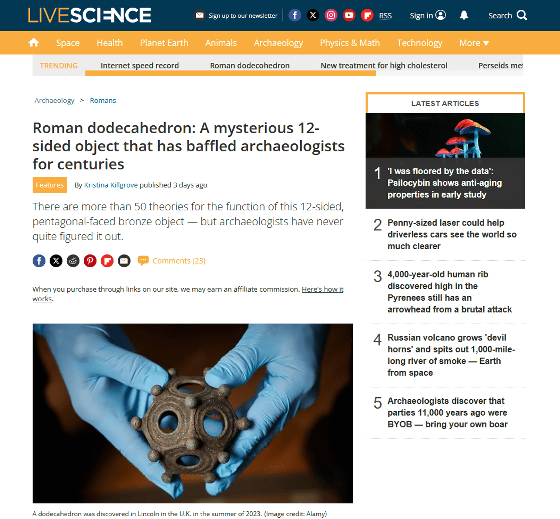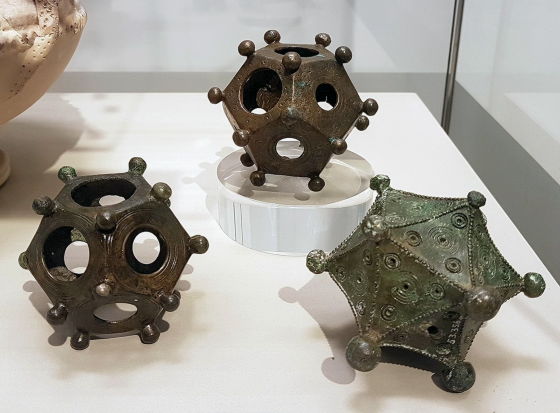The Roman Hollow Dodecahedron that has puzzled archaeologists for over 200 years

by Wikimedia Commons
The mysterious artifacts '
Roman dodecahedron: A mysterious 12-sided object that has baffled archaeologists for centuries | Live Science
https://www.livescience.com/archaeology/romans/roman-dodecahedron-a-mysterious-12-sided-object-that-has-baffled-archaeologists-for-centuries

According to archaeologist Michael Guggenberger , all of the Roman hollow dodecahedrons were made between the late 2nd and late 4th centuries AD and have the same overall appearance.
The basic shape is a dodecahedron with 12 pentagons forming hollow faces, which meet at 20 corners. Each corner has a small sphere on it, and each pentagon has a hole of a different diameter. The dodecahedron is about 4-10 cm tall and weighs about 30-580 g, and is characterized by its very thin walls. No Roman hollow dodecahedrons with inscriptions have been found.
Below is a photo of the Roman hollow dodecahedron.

by
Roman hollow dodecahedrons have been found in Austria, Belgium, France, Germany, Great Britain, Hungary, Luxembourg, the Netherlands, France and Switzerland, but none in Italy.
From this point of view, Göggenberger believes that the Roman hollow dodecahedron is a relic of the ' Gallo-Roman culture ' that developed independently in Gaul (present-day France, Belgium, Switzerland, the Netherlands, Germany, etc.) under the rule of the Roman Empire, and may have originated from the Celtic peoples .
However, since no historical records or artwork depicting the Roman hollow dodecahedron have been found, its exact origin and use remain unknown. They have been found in a variety of locations, including the tombs of men and women, a coin hoard, and a rubbish heap, and there is no comprehensive explanation of their use.
Many archaeologists have attempted to solve the mystery of the Roman hollow dodecahedron, and various hypotheses have been put forward as to its true identity, including 'weapons,' 'ornaments,' 'candlesticks,' 'rangefinders,' 'measuring instruments,' 'children's toys,' 'dice,' 'artisan's samples,' and 'spools of thread.'

by Wikimedia Commons
Geggenburger points out that of the more than 50 hypotheses that have been proposed so far, most can be dismissed or are extremely unlikely. The hypothesis that Geggenburger supports is related to the ancient Greek philosopher Plato .
Plato inherited the theory from the natural philosopher Empedocles that the matter in this world is made up of four elements: fire, air, water, and earth, and further related it to five types of regular polyhedrons. In Plato's theory, the regular tetrahedron corresponds to fire, the regular cube to earth, the regular octahedron to air, and the regular icosahedron to water, and the remaining regular dodecahedron was thought to exist for the sake of the universe.
After Plato's death, thinkers such as Plutarch revived the idea of the dodecahedron as a symbolic link to the heavens and the universe around the 2nd century AD, and this may have influenced the Celts under the influence of the Roman Empire, Gegenberger argues .
A Roman hollow dodecahedron discovered in a German woman's grave in 1966 was placed next to a bone rod, suggesting that the Roman hollow dodecahedron may have been held up on a rod. 'The most likely interpretation of the Roman hollow dodecahedron to date is as an all-embracing cosmic symbol,' Geggenburger said in a 2000 study .
in Note, Posted by log1h_ik